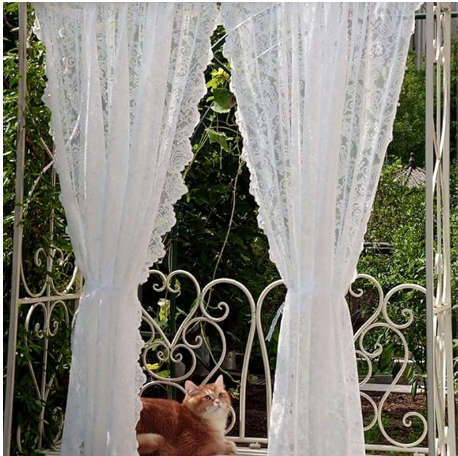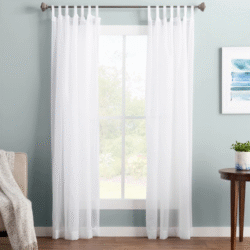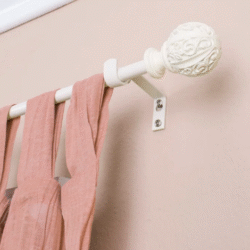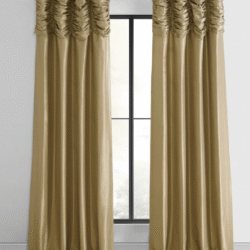victorian lace curtains are a timeless symbol of elegance and sophistication, offering a delicate yet intricate design that can transform any space. Originating during the Victorian era, these curtains reflect the period’s penchant for ornate and elaborate decoration, combining both functionality and beauty. Made from fine lace, often with floral or geometric patterns, they allow for a soft diffusion of light while maintaining a level of privacy. The intricate craftsmanship of Victorian lace curtains is not only a nod to the past but also a versatile addition to contemporary interiors. Whether draped in living rooms, dining areas, or bedrooms, they evoke a sense of nostalgia while seamlessly enhancing modern home decor.
The History of Victorian Lace Curtains
The history of Victorian lace curtains is deeply rooted in the cultural and aesthetic developments of the Victorian era, spanning from 1837 to 1901. During this period, there was a strong emphasis on ornate, intricate designs and a love for decorative home furnishings. Lace curtains, in particular, became a symbol of sophistication and refinement, serving both as a decorative element and a functional window treatment. The rise of industrialization during the Victorian era led to the mass production of lace, making it more affordable and accessible to the middle class, who sought to replicate the grandeur of aristocratic homes.
Lace curtains were typically made from fine threads of cotton, linen, or silk, often featuring elaborate floral or geometric patterns. These designs were crafted using traditional lace-making techniques, such as bobbin lace or needle lace, which required a high level of skill and attention to detail. Victorian lace curtains were not just about aesthetics; they played a practical role in providing privacy while still allowing natural light to filter through, an important feature in the densely populated urban settings of the time.
As the Victorian era came to a close, lace curtains continued to be a popular choice for home décor, adapting to changing tastes and styles. Today, they remain a beloved piece of vintage charm, evoking the elegance and class of a bygone era while still adding a touch of timeless beauty to modern interiors.
Designs and Patterns of Victorian Lace Curtains
- Floral Motifs: Commonly featured in Victorian lace curtains, floral patterns such as roses, daisies, and vines were popular, symbolizing nature and beauty.
- Geometric Patterns: Intricate geometric shapes, including diamonds, hexagons, and lattice designs, were often incorporated to add structure and balance to the lace.
- Border Detailing: Many Victorian lace curtains included detailed borders, often with scalloped or zigzag edges, to enhance their visual appeal.
- Symmetry: Victorian lace patterns often favored symmetry, creating a balanced and harmonious look that complemented the decor of the time.
- Meandering Designs: Flowing, curving lines, resembling vines or tendrils, were commonly used to create an organic and natural feel within the design.
- Layered Patterns: Lace curtains sometimes featured layered or multi-dimensional patterns, where the lace was woven in different ways to create depth and texture.
- Textured Weaves: Variations in the texture of the lace, achieved by different weaving techniques, added an extra layer of complexity to the design.
- Intricate Detailing: Fine craftsmanship led to highly detailed patterns that required significant time and skill to produce, often showcasing delicate, ornate elements.
- Light and Shadow Play: The open spaces in lace designs allowed light to filter through, creating beautiful shadows and effects in the room.
- Custom Designs: High-end Victorian lace curtains were often custom-designed to suit specific windows and interior styles, offering a personal touch to each home.
Materials Used in Victorian Lace Curtains
- Cotton: One of the most common materials used in Victorian lace curtains, cotton offered a delicate yet durable texture. It was easy to dye and allowed for intricate lace patterns while maintaining affordability.
- Linen: Known for its smooth texture and strength, linen was also a popular choice for Victorian lace curtains. It had a natural sheen that gave lace curtains a refined, elegant look.
- Silk: For high-end, luxurious lace curtains, silk was often used due to its softness and natural sheen. Silk lace was more delicate and expensive, adding an air of sophistication and exclusivity to Victorian homes.
- Wool: Though less common, wool was sometimes incorporated into lace designs, especially for heavier curtains intended for colder climates. It added warmth and a soft texture to the fabric.
- Thread: The lace patterns themselves were made from fine, twisted threads, often crafted from cotton, silk, or linen. These threads were carefully woven or knotted to create the intricate designs characteristic of Victorian lace.
- Blend Fabrics: Some Victorian lace curtains were made from a blend of materials to combine the strength of cotton with the sheen of silk or the smoothness of linen, offering a balance of durability and elegance.
- Metallic Threads: For decorative touches, some Victorian lace curtains featured metallic threads, often in gold or silver, adding a touch of glamour and luxury to the design.
- Machine-Made Lace: As industrialization progressed, machine-made lace became more common, making it easier to produce lace curtains in larger quantities while maintaining the intricate designs of hand-made lace.
How Victorian Lace Curtains Enhance Home Décor
- Elegant Aesthetic: Victorian lace curtains add a touch of vintage elegance, transforming any room into a sophisticated and timeless space.
- Soft Light Diffusion: The delicate lace allows soft, diffused light to filter into the room, creating a warm, inviting atmosphere.
- Intricate Detailing: The detailed, ornate patterns in Victorian lace curtains serve as a focal point, adding texture and visual interest to windows and walls.
- Privacy with Style: While offering privacy, the semi-transparent nature of lace curtains maintains a sense of openness, ideal for urban settings.
- Versatility in Design: Victorian lace curtains complement a variety of interior styles, from classic and traditional to modern vintage and shabby chic.
- Timeless Appeal: Their enduring design makes Victorian lace curtains a lasting addition to any home, blending seamlessly with both period and contemporary furniture.
- Enhancing Room Atmosphere: Lace curtains contribute to a calming, romantic ambiance, ideal for bedrooms, living rooms, and dining areas.
- Adding Texture: The intricate lace texture adds depth and dimension to flat surfaces like walls and windows, making rooms feel more dynamic.
- Refined Touch to Interiors: Victorian lace curtains elevate the overall décor, contributing to a more refined and polished home environment.
- Complementing Other Décor Elements: Their delicate designs pair beautifully with vintage furniture, antique pieces, or floral upholstery, enhancing the overall décor cohesion.
Caring for and Maintaining Victorian Lace Curtains
Caring for and maintaining Victorian lace curtains is essential to preserve their delicate beauty and intricate craftsmanship. Due to the fine and often fragile nature of the fabric, proper care is crucial to prevent damage and ensure their longevity. First and foremost, regular dusting is recommended to prevent dust buildup, which can lead to discoloration over time. A gentle hand or a soft brush can be used to carefully remove dust from the lace without disturbing the intricate patterns.
When cleaning, it’s important to avoid harsh chemicals or heavy washing, as these can weaken the fabric. Hand washing is often the safest method, using lukewarm water and a mild detergent specifically designed for delicate fabrics. The lace should be gently submerged, avoiding any harsh scrubbing or twisting. After washing, the curtains should be air-dried by laying them flat or hanging them gently on a clothesline, ensuring they are not exposed to direct sunlight for prolonged periods, as this can cause fading.
For stubborn stains, professional cleaning or spot cleaning may be necessary to avoid causing damage. It’s also advisable to periodically check the lace for any signs of wear, such as fraying or holes, and address these issues immediately with careful stitching or reinforcement. Proper storage, such as hanging or storing the curtains in a cool, dry place, helps protect them from environmental factors that can cause deterioration. With attention and care, Victorian lace curtains can remain a beautiful and lasting addition to any home.
Victorian Lace Curtains in Modern Interiors
Victorian lace curtains have found a unique place in modern interiors, offering a timeless elegance that complements contemporary design elements. Their delicate, intricate patterns add texture and charm to spaces, providing a sense of history and sophistication while seamlessly blending with modern décor. In modern homes, these lace curtains are often used to create contrast, combining their vintage appeal with sleek, minimalistic furniture or industrial-style interiors. The soft, filtered light that Victorian lace curtains allow into a room enhances the atmosphere, creating a warm, inviting environment in otherwise stark, modern spaces.
These curtains work beautifully in living rooms, bedrooms, and dining areas, adding a sense of romance and intimacy to the design. They can be paired with more contemporary drapes or blinds to balance their light, airy texture with heavier fabrics, creating a layered look that is both functional and stylish. Victorian lace also fits perfectly in eclectic or shabby-chic interiors, where the juxtaposition of old and new elements creates a unique aesthetic.
In addition to their visual appeal, Victorian lace curtains offer practical benefits, such as privacy without completely blocking natural light. Their ability to allow light to filter through while maintaining a sense of seclusion makes them an ideal choice for urban environments or smaller spaces where privacy is important. In modern interiors, Victorian lace curtains serve as a beautiful reminder of the past while effortlessly enhancing the style of any room.
conclusion
In conclusion, Victorian lace curtains are more than just a window treatment; they are a symbol of elegance, history, and intricate craftsmanship. Originating from the Victorian era, these curtains have stood the test of time, continuing to enhance both traditional and modern interiors. Their delicate patterns and soft textures bring a touch of vintage charm, creating a warm and inviting atmosphere in any space. Whether used for their aesthetic beauty, their ability to filter light while ensuring privacy, or their role in evoking a sense of nostalgia, Victorian lace curtains remain a timeless choice for homeowners. Proper care and maintenance can ensure these exquisite pieces continue to grace homes with their unique style, making them a cherished addition to any décor.




